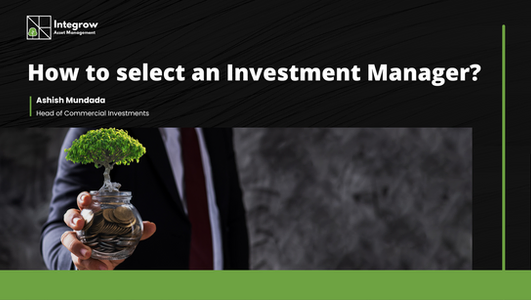Investors strive to select a top quartile investment manager (or AMC) because the cost for selecting a wrong manager is huge. And this is even more prominent in alternatives! According to CRISIL, for alternative investment funds (AIF Category II), the IRR differential between Top Quartile and Bottom Quartile manager is more than 5% and, in some cases, it is more than 15%!
Typically, investors have cited luck or lack of access to brand name investment managers as the most common reason for lower returns. However, Cavagnaro, Senoy, Wang and Weisbach researched performance of more than 12,000 fund investments made by more than 600 investors (limited partners / LPs in fund parlance). According to their research paper published in 2016, an investor’s skill in selecting a right investment manager is more important than luck or access to a brand name investment manager for generating superior returns. In simple words, it is in investors’ own hands to boost their returns by selecting right investment managers.
The 4C methodology can be an important framework that investors can apply when selecting investment managers.
What is the 4C methodology?
The 4C methodology is a framework that helps investors evaluate the quality and performance of investment managers. It consists of four main criteria: Competence, Culture, Conflict of interest and Compensation.
Competence
Competence refers to the ability and expertise of an investment manager to execute the investment strategy of a fund and achieve its objectives.
It includes factors such as:
– Philosophy: The underlying principles and beliefs that guide the investment manager’s decisions and actions.
– Process: The systematic and disciplined approach that the investment manager follows to identify, analyse, select, monitor and exit investments.
– Capabilities: The resources and methods that the investment manager uses to gather, process and interpret information relevant to its investments.
– Track record: The historical results that the investment manager has achieved in terms of risk-adjusted returns, consistency and benchmark comparison.
– Risk management: The policies and procedures that the investment manager has in place to identify, measure, manage and mitigate various types of risks associated with its investments.
Culture
Culture refers to the values and behaviours that shape the investment manager’s organizational environment and influence its decision-making. Culture can be a silent enabler or a silent killer of a fund’s performance.
It includes factors such as:
– Leadership: The vision, direction and guidance that the senior management provides to the investment team and the organization as a whole.
– Teamwork: The degree of collaboration, communication and coordination among the investment team members and across different functions within the organization.
– Innovation: The extent to which the investment manager encourages creativity, experimentation and learning from failures.
– Accountability: The level of integrity, responsibility and ownership that the investment team members take for their actions and outcomes.
– Ethics: The standards of conduct and integrity that the investment manager adheres to in its dealings with clients, regulators, counterparties and other stakeholders.
Conflict of interest
Conflict of interest refers to the situations where an investment manager’s interests may diverge from those of its clients/fund investors or where an investment manager may face competing demands or pressures from different parties or different businesses. In short, is the investment manager a true fiduciary with zero conflict of interest?
It includes factors such as:
– Alignment of interests: The degree to which the investment manager’s incentives are aligned with those of its clients/fund investors in terms of fees, expenses, co-investment, performance measurement and reporting.
– Independence: The extent to which the investment manager can make objective and unbiased decisions without being influenced by external factors as well as, and more so, internal factors.
– Transparency: The level of disclosure and communication that the investment manager provides to its clients regarding its operations, investments, risks and performance.
– Governance: The structure and processes that the investment manager has in place to ensure oversight, control and compliance with laws, regulations and best practices.
Compensation
Compensation refers to the amount and structure of remuneration that an investment manager pays to its investment team, partners and employees.
It includes factors such as:
– Base salary: The fixed component of compensation that reflects the role, experience and qualifications of an employee or partner.
– Bonus: The variable component of compensation that depends on the performance of an employee or partner, the investment team or the organization as a whole.
– Long-term incentives: The deferred or contingent component of compensation that aligns the interests of an employee or partner with those of the clients/fund investors over the fund’s entire life. This can be in the form of carry/profit sharing in a fund and/or ESOPs.
How to apply the 4C methodology?
The 4C methodology can be applied by investors as an integral part of their investment manager selection process. For example:
– Screening: Investors can use the 4C criteria to filter out investment managers that do not meet their minimum requirements or expectations.
– Due diligence: Investors can use the 4C criteria to conduct a comprehensive and in-depth analysis of the investment managers that pass the screening stage.
– Negotiation: Investors can use the 4C criteria to negotiate the terms and conditions of their investment agreements with the selected investment managers.
– Monitoring: Investors can use the 4C criteria to evaluate the performance and behaviour of their investment managers on an ongoing basis.
The 4C methodology is not a rigid or prescriptive formula, but rather a flexible and adaptable tool that investors can customize according to their preferences, objectives and constraints.
Conclusion
The 4C methodology can help investors select a high-quality investment manager by evaluating its stellar competency, culture of excellence, zero conflict of interest and appropriate compensation structure.
By rigorously applying the 4C methodology, investors can greatly enhance their chances of generating top quartile returns and avoiding costly mistakes!
Basic due diligence questions to ask an AMC/investment manager (not a comprehensive list)
1. Is the investment manager/AMC a true fiduciary i.e. has no other lines of business?
2. If an investment manager or its holding company has other lines of business, then is “investment management” their core competency?
3. What are investment and corporate reporting standards?
4. What are investment committee memorandum (IC memo) standards?
5. How qualified are the fund’s and the AMC’s auditors? Did they report any exceptions/unusual observation? Have there been any findings by SEBI, RBI or other government bodies?
6. What are the repercussions to non-performing fund managers?
7. How are misdemeanors of the best performing fund managers handled?
8. Does each investment strategy have a separate investment and asset management teams? Or are the resources shared?
9. How are fraudulent activities of the employees, especially the investment team, monitored?
10. Does the company have deal allocation policy?
11. Does the company permit tying of investment and non-investment products?
12. Does each level of title/promotion have a clearly defined role, responsibility, and authority?
13. Are the monetary incentives aligned with the objectives & tenor of the fund and its investors?
14. Have the fund managers of good performing funds left the organization?
15. How does the compensation benchmark against the other funds/AMCs?
16. Is the IRR reported appropriately or shown opportunistically? Is the IRR realized or projected? Is it a deal level IRR or a portfolio level IRR?
17. Is the investment manager strictly adhering to the investment mandate? How many exceptions or special cases the investment manager has had during the deployment of the previous funds?
18. Is the performance generated by the team balanced across the team? Or is it skewed to certain individuals? Or is it the performance of individuals who have left or retired from the company?
19. How competent are the external advisors that the team hires for the deal due diligence?
20. Can the AMC fulfil all of its commitments in all business cycles?
Writer : Ashish Mundada





